“Trees are Terrific…and Forests are Too” is the national theme this year for Arbor Day. Since ancient times trees have held a significant place in cultures worldwide. Trees have been considered sacred, offering immortality, and the axis mundi, the cosmic axis connecting heaven, earth, and the underworld.
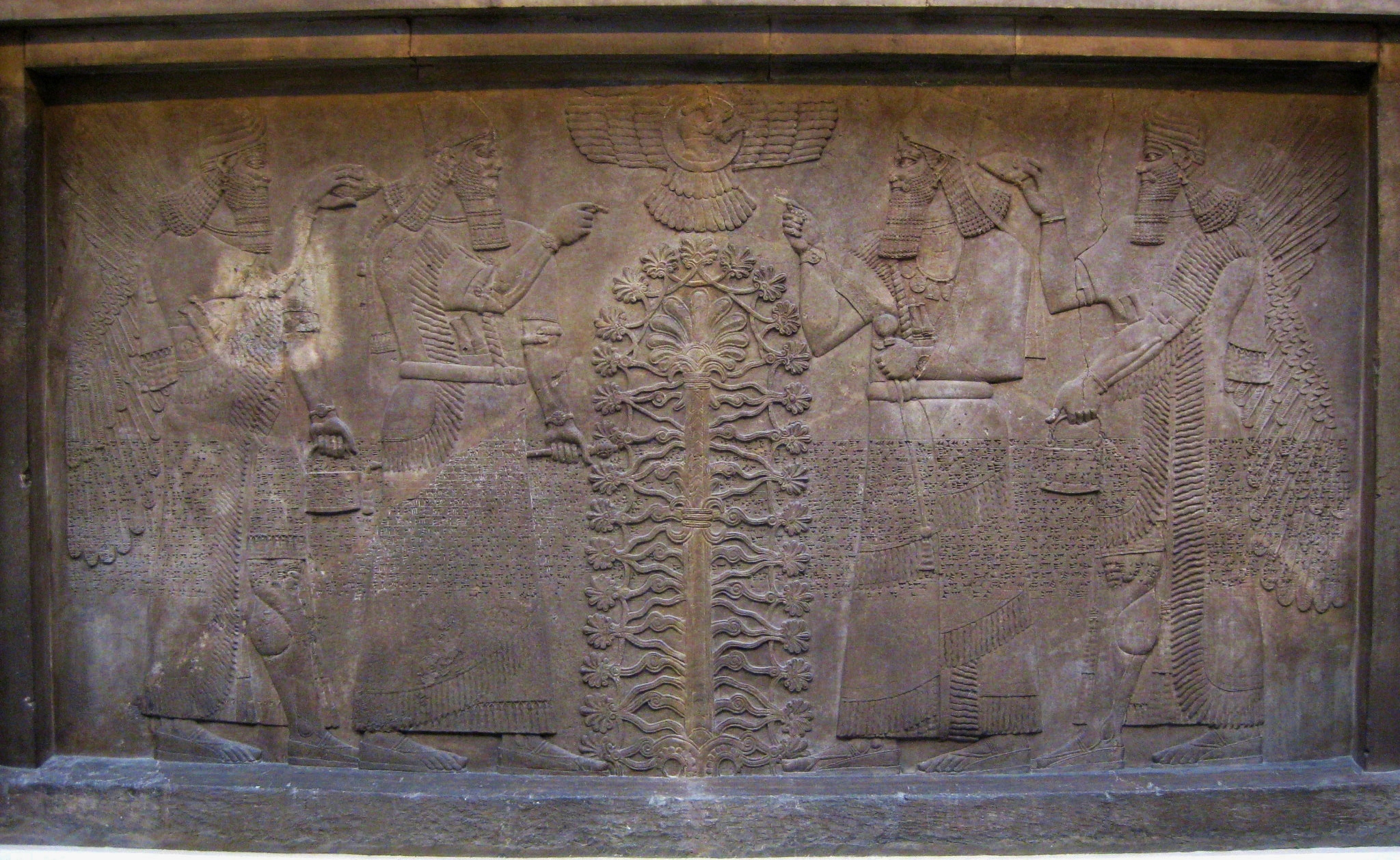
“Tree of Life” (883-859 BCE)
This image of the sacred Tree of Life (883-859 BCE) (Palace of Nimrud) is carved onto slabs of alabaster in the corridors of the palace of the first great Neo-Assyrian king Ashurnasirpal II. The tree of life is the central figure, and the king’s image is repeated on both sides of the tree. The fruit and seeds provided sustenance. They are also associated with fertility. The straight tree trunk is covered with fruit, and growing from it are rows of three and single branches. Round fruit is placed among the branches, and palmettos at the end of the branches. The fruit is often identified as a pomegranate. A crown of leaves tops the trunk.
On both sides of the tree are duplicate images of King Ashurnasirpal II, both pointing above the tree to the circular disc supported by wings. In the circle is the image of the supreme god Ashur, God of war, wisdom, justice, and agriculture. Ashur’s placement above the divine tree legitimized the king’s rule of the heavens and the earth. He presents Ashurnasirpal II the ring that conveys the authority to rule.
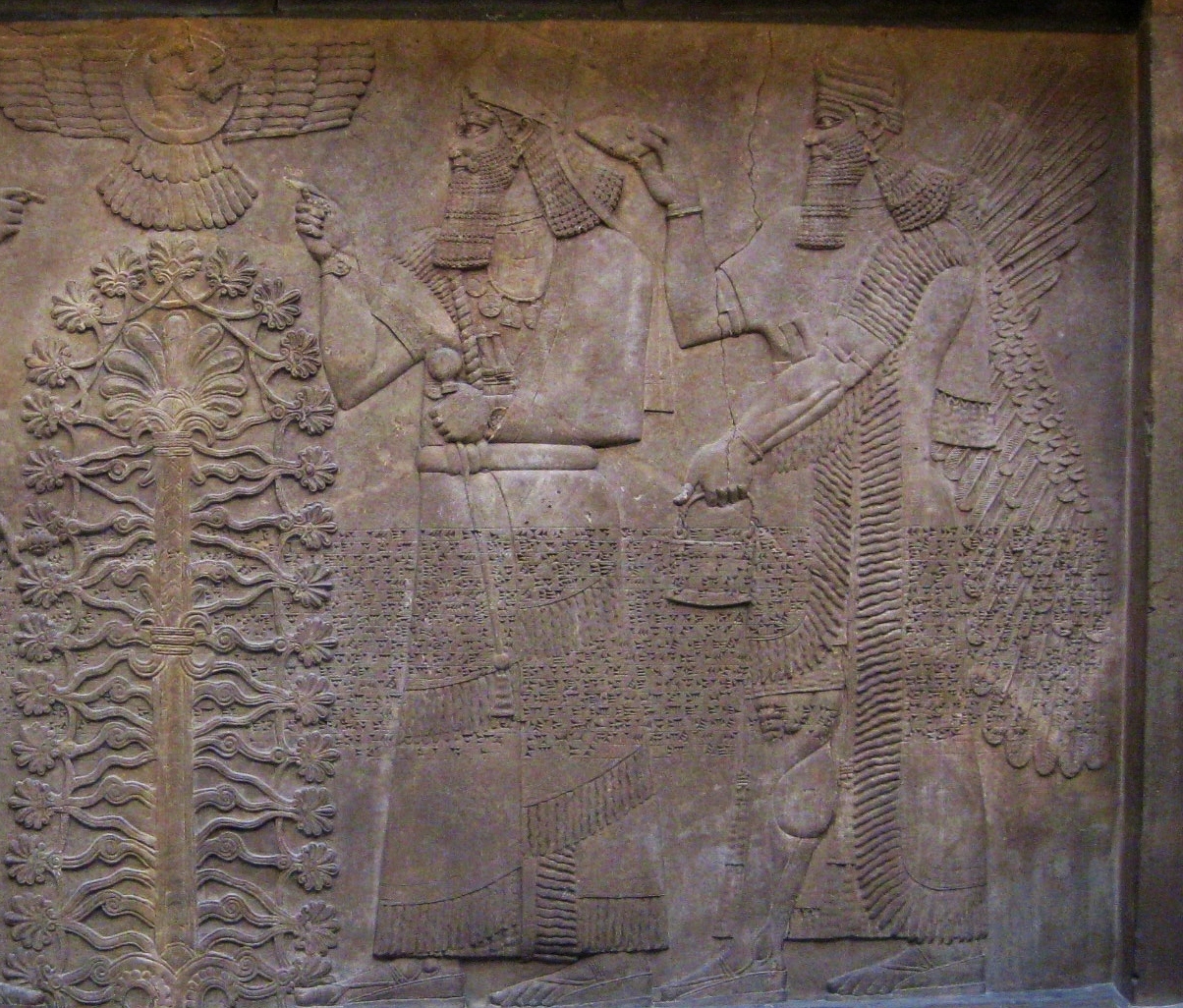
“Tree of Life” (detail of right side)
Beyond the king are winged genies, each carrying a pail of water and a pine cone. Frequently presented with the tree of life, the image is a depiction of the genie fertilizing and tending to the tree. Genies also are guardians of the king. Both the king and the genie are dressed in imperial robes. Long fringes of hair hang from the shoulders of the robes. The king wears a necklace and bracelet containing images of flowers and other sacred symbols. Men in Mesopotamia traditionally are depicted with long elaborately curled hair and beards, detailed mustaches and eyebrows, and fringes or tassels of hair on their robes. Hair was a symbol of strength. From the same location and time, Samson, from the Old Testament of the Bible, had long hair which was his strength. The male figures have exaggerated musculature in their arms and legs to show strength, noticeable in the figure of the genie.
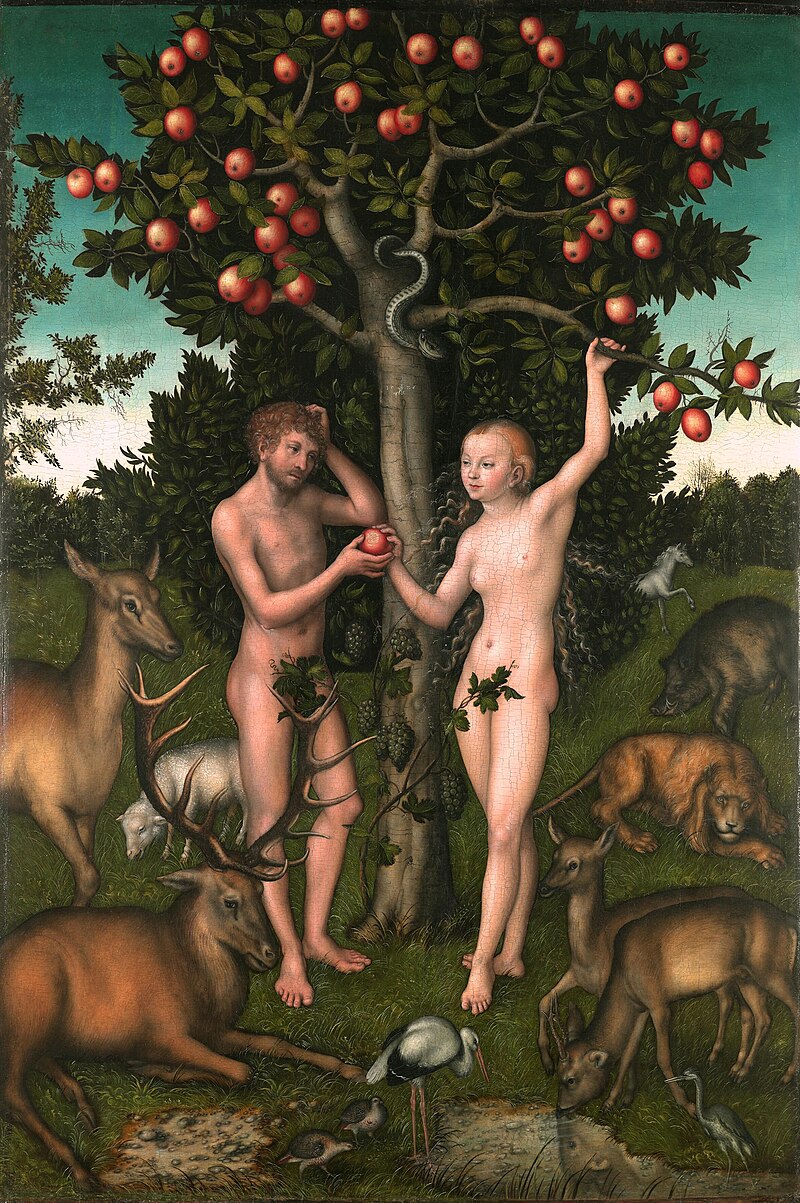
“Adam and Eve in the Garden of Eden” (1526)
The Jewish Torah, the first five books of the Old Testament in the Christian Bible, relates the story of Adam and Eve in the Garden of Eden. The prominent trees are the Tree of Life and the Tree of Knowledge of Good and Evil. God offers Adam and Eve the fruit of the trees to eat, including the Tree of Life, which would confer eternal life in Paradise. God forbids them to eat the fruit of only one tree, the Tree of Knowledge, which would confer the knowledge of good and evil.
“Adam and Eve in the Garden of Eden” (1526) (46”x81’’), painted by German artist Lucas Cranach the Elder (1472-1553), depicts the story in which the serpent tempts Eve to eat the fruit, and she in turn convinces Adam to eat. The Tree of Life is rarely is depicted in the illustration of the story, whereas the Tree is Knowledge in prominent. The animals of Eden live together in peace: the lion and the lamb, deer, elk, wild boar, quail, heron, and white unicorn. Grape vines encircle the trunk; the tree produces an abundance of apples. Slithering down the trunk, the serpent looks at Eve. A somewhat reluctant Adam scratches his head while making his decision. Cranach’s painting is typical of those telling this story.
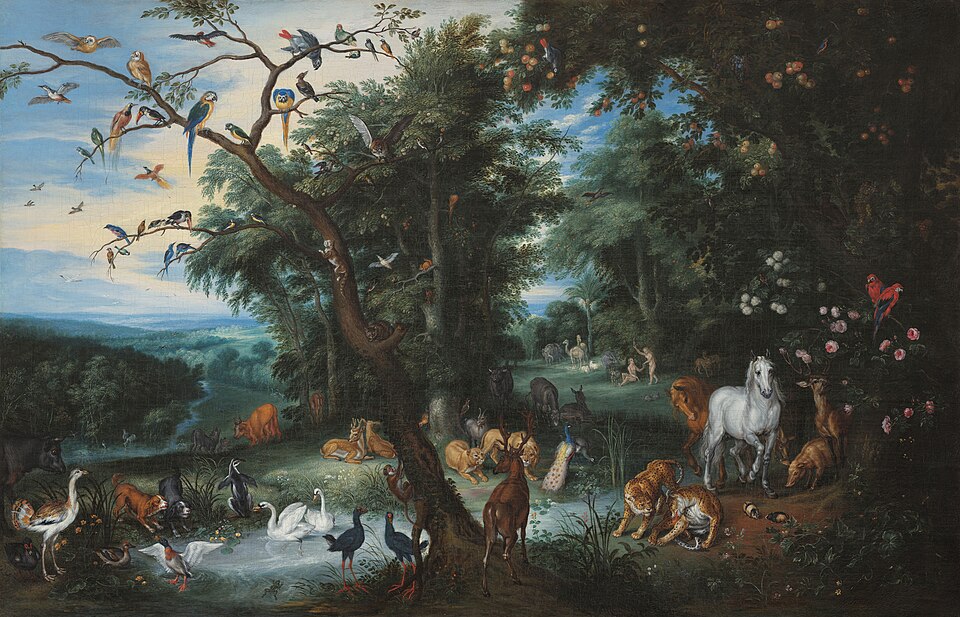
“The Garden of Eden” (1655-61)
“The Garden of Eden” (1655-61) (23’’x35’’), by Flemish painter Isaak van Oosten (1631-1661), is a depiction of a large and glorious Paradise. Animals of all kinds are in pairs, and the birds are painted in great numbers. The trees are in full bloom. Plants, fruit, and flowers are abundant. Van Oosten preferred painting landscapes and animals, and created several of Eden. Although he was a Protestant, his paintings associate the Torah’s theological emphasis on Eden as the Promised Land for God’s people.
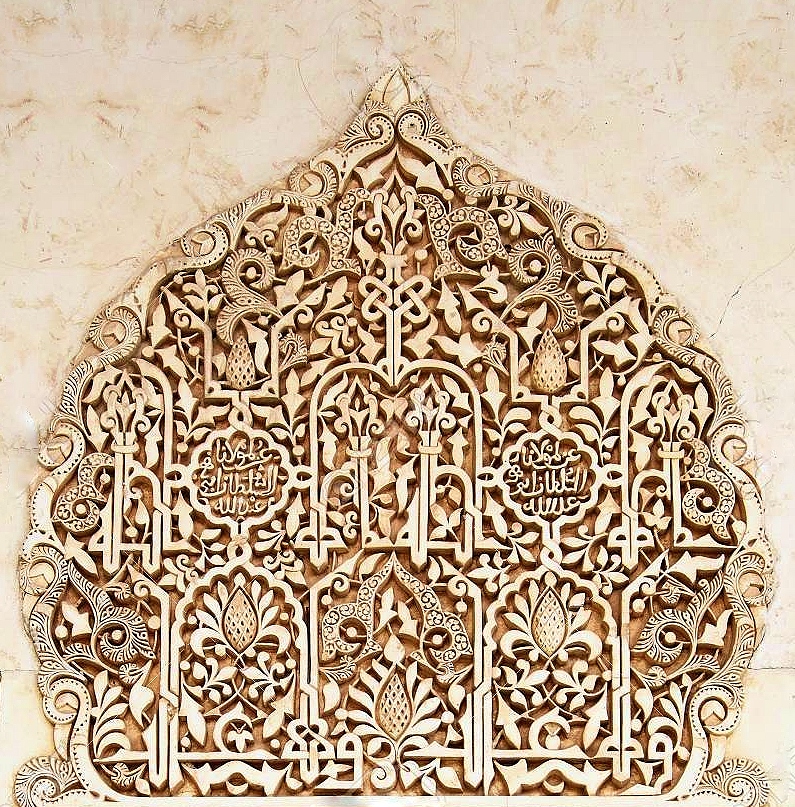
Tree of Life” (1362-1367)
“Tree of Life” (1362-1367) (Court of the Myrtles) is one of the many times this Islam motif appears in the Quran and the Hadiths. Hadith is the Arabic word for a report or account of an event, and they are the sayings of Mohammad. The Quran mentions only one tree in the Garden of Eden, the Tree of Immortality, from which Allah forbids Adam and Eve to eat. They are tempted by Satan and eat from the tree.
Muslim prayer rugs frequently contain the image of the tree of life in the design. “Tree of Life” (1362-1367) is carved stucco on the walls of the Court of the Myrtles in the Alhambra in Granada, Spain. The design is symmetrical and balanced. Rather than one trunk, the design starts with three pine cones, surrounded by flower petals and a supporting geometric structure. The second level has two sayings from the Quran, and the geometric structure continues. The third level has a trunk-like design in the center which blooms into a peak at the top. The curving sides of the tree, and the various designs within it create upward movement. The Islamic Tree of Life is designed to show a connection between Heaven and Earth.
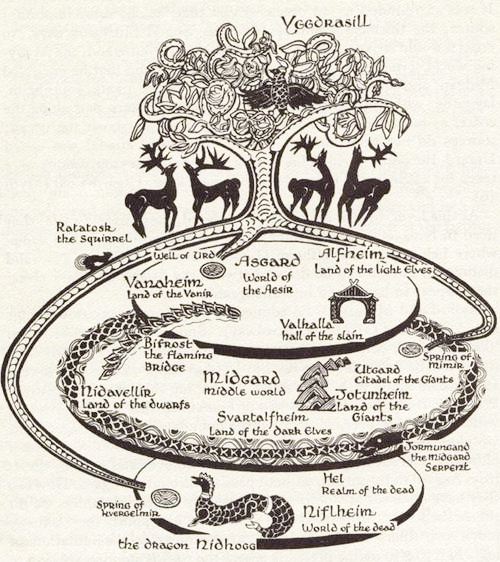
“Yggdrasil” (1847)
“Yggdrasil” (1847) is a depiction of the cosmic tree that is the central axis of the Norse universe and connects all nine realms. It has three roots. It is a sacred Ash tree, the source of all wisdom. Depicted here are the eagle with the head of a hawk perched in the tree and reports what it sees to the gods in Asgard who meet under it. The four stags represent the four winds. They eat branches of the tree, and their antlers drop dew on the earth below. The first root leads to the well of Urd where the three fates (Norns) live. They tend the tree and determine the lifespan of people. The squirrel Ratatosk is the messenger to the gods, running back and forth from Asgard to Niflheim, the realm of the dead. In Asgard, the Bifrost Bridge is the rainbow that connects Midgard and Asgard. Heimdall stands guard over the bridge. He keeps his horn with him, and he will blow it to signal Ragnarök, the end of the world. Slain Viking warriors rest in Valhalla until they return to fight in this last great battle.
The second root leads to Midgard, the realm of humans. Midgard also contains the regions of the dwarfs, the giants, and the dark elves. Midgard, mentioned in Beowolf, is surrounded by the Midgard serpent Jormungand. The third and lowest root leads to Niflheim. The goddess Hel presides over the dark realm Helheim, a world of ice where the dragon Nidhogg, tearer of corpses, presides.
Yggdrasil represents the connection between life, death, and rebirth in Norse mythology. Unfortunately, the myth was passed down verbally and much of it has been lost. The Prose Edda, the first known writing of Norse mythology in Iceland during the 13th Century, has been attributed to Snorri Sturluson. The illustrations of Yggdrasil are not from the 13th Century; they were added to later printings of the Prose Edda.
The symbolism of trees is significant for many belief systems and for many reasons. Buddha received enlightenment under the Bodhi tree, Christ’s lineage is traced through the Tree of Jesse, and today family trees have become more and more important. Arbor Day in Chestertown will be celebration this Saturday. For those who attend, saplings to plant will be distributed. Trees are important to sustain the environment. Enjoy Saturday in the park in Chestertown and plant a tree.
Note: Maryland Governor Wes Moore proclaimed April 2, 2025 as the 142nd annual Maryland Arbor Day celebration. In 2021 a Maryland initiative was to plant five million trees. As of this writing, Maryland has celebrated a milestone of one million trees planted.
Beverly Hall Smith was a professor of art history for 40 years. Since retiring to Chestertown with her husband Kurt in 2014, she has taught art history classes at WC-ALL and the Institute of Adult Learning, Centreville. An artist, she sometimes exhibits work at River Arts. She also paints sets for the Garfield Theater in Chestertown.
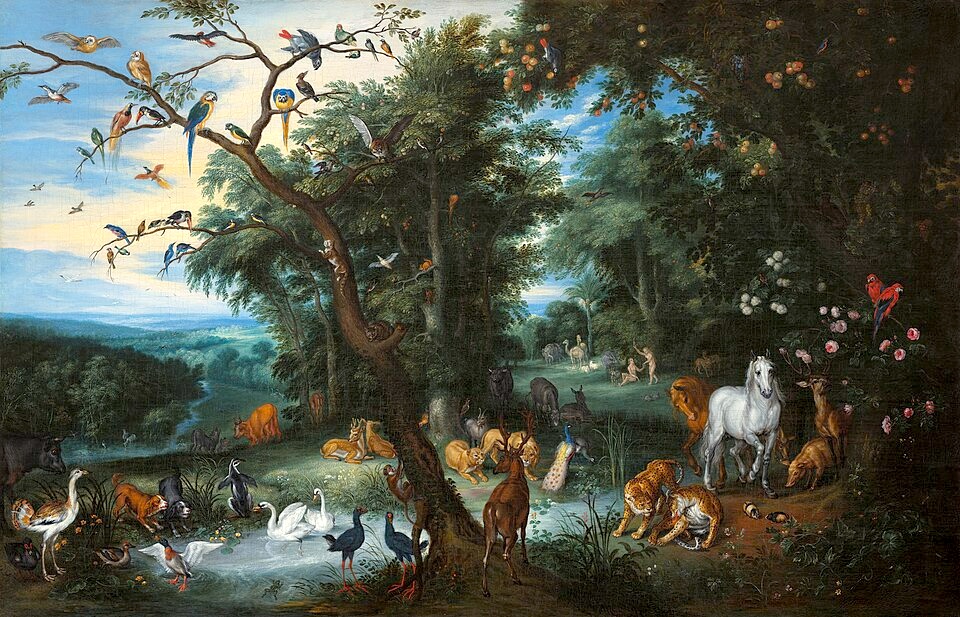


Write a Letter to the Editor on this Article
We encourage readers to offer their point of view on this article by submitting the following form. Editing is sometimes necessary and is done at the discretion of the editorial staff.